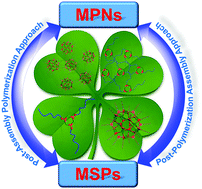When polymerization meets coordination-driven self-assembly: metallo-supramolecular polymers based on supramolecular coordination complexes
Abstract
Polymers have greatly changed and are still changing the way we live ever since, and the construction of novel polymers as functional materials remains an attractive topic in polymer science and related areas. During the past few years, the marriage of discrete supramolecular coordination complexes (SCCs), including two-dimensional (2D) metallacycles and three-dimensional (3D) metallacages, and polymers gave rise to two novel types of metallo-supramolecular polymers, i.e., metallacycle/metallacage-cored star polymers (MSPs) and metallacycle/metallacage-crosslinked polymer networks (MPNs), which has attracted increasing attention and emerged as an exciting new research direction in polymer chemistry. Attributed to their well-defined and diverse topological architectures as well as the unique dynamic features of metallacycles/metallacages as cores or crosslinks, these novel polymers have shown extensive applications. In this review, aiming at providing a practical guide to this emerging area, the introduction of synthetic strategies towards MSPs and MPNs will be presented. In addition, their wide applications in areas such as functional materials, molecular sieving, drug delivery, bacterial killing and bioimaging are also discussed.



 Please wait while we load your content...
Please wait while we load your content...